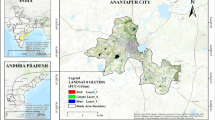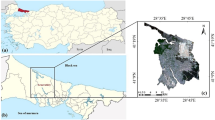Abstract
Analysis of land use and land cover change is of prime importance for understanding the ecological dynamics resulting from natural and human activities, and for the assessment and prediction of environmental change. The population of the Gaza Strip will have grown to more than 2.4 million by 2023 all of whom are forced to live within an area of some 365 km2. This growth in population will lead to an increase in land demand, and will far exceed the sustainable land use capacity. The Gaza Strip is a relatively small area in which land use planning has not kept up with land development. Continued urban expansion and population growth in the future will place additional stress on land cover, unless appropriate integrated planning and management decisions are taken immediately. Decision-makers need further statistics and estimation tools to achieve their vision for the future of the Gaza Strip based on sound, accurate information. This study combines the use of satellite remote sensing with geographic information systems (GISs). The spatial database was developed by using six Landsat images taken in 1972, 1982, 1990, 2002, 2013 and 2014, together with different geodatabases for those years. Five past trend scenarios were selected for simulation to be completed by the year 2023 using the Land Change Modeler in the Idrisi Terrset software. These different scenarios, one of which takes into account the damage incurred during the 2014 War, try to cover the possible variations in areas and spatial distribution resulting from changes in land use. As an average over the five scenarios, by 2023 the projected urban area will have increased to 206.24 km2 or 57.13% of the Gaza Strip.
Access this chapter
Tax calculation will be finalised at checkout
Purchases are for personal use only
Similar content being viewed by others
References
Abuelaish B, Camacho Olmedo MT (2016) Scenario of land use and land cover change in the Gaza Strip using Remote Sensing and GIS models. J: Arab J Geosci. http://dx.doi.org/10.1007/s12517-015-2292-7
Alcamo J, Kok K, Busch G, Priess J (2008) Searching for the future of land: Scenarios from the local to global scale. In: Alcamo J (ed) Environmental futures: the practice of environmental scenario analysis. Elsevier, Amsterdam, The Netherlands
Curran PJ (1985) Principles of remote sensing. In: Remote sensing today. longman scientific & technical, London
Duh JD, Shandas V, Chang H, George LA (2006) Rates of urbanisation and the resiliency of air and water quality. Sci Total Environ 400(1–3):238–256
Eastman JR (2012) Idrisi Selva Tutorial. Clark University, Worcester, MA, USA
Eastman JR, Jin W, Kyem W, Toledano P (1995) Raster procedures for multi-criteria? Multi-objective decisions. Photogramm Eng Remote Sens 61(5):539–547
Ennab WR (1994) Population and demographic developments in the West Bank and Gaza Strip until 1990. UNCTAD, Geneva
Goodchild MF (2005) GIS and modeling overview. In: Maguire DJ, Batty M, Goodchild MF (eds) GIS, Spatial analysis, and modeling. Redlands, CA: ESRI Press, pp 1–18
Haas J, Ban Y (2014) Urban growth and environmental impacts in Jing-Jin-Ji, the Yangtze River Delta and the Pearl River Delta. Int J Appl Earth Obs Geoinf 30:42–55
Hualou L, Guoping T, Xiubin L, Heilig GK (2007) Socio-economic driving forces of land-use change in Kunshan, the Yangtze River Delta economic area of China. J Environ Manag 83:351–364
Janssen LLF (1993) Methodology for updating terrain object data from remote sensing data: the application of landsat TM Data with respect to agricultural fields. Dissertation Wa-geningen Agricultural University
Mas JF, Kolb M, Paegelow M, Camacho Olmedo MT, Houet T (2014) Inductive pattern-based land use/ cover change models: a comparison of four software packages. Environ Model Softw 51(2014):94–111. doi:10.1016/j.envsoft.2013.09.010
Nakicenovic N, Swart R (eds) (2000) IPCC special report on emission scenarios. Cambridge University Press, Cambridge, UK
Paegelow M, Camacho Olmedo MT (2008) Modelling environmental dynamics. Advances in geomatic simulations. Series environmental science. Springer, Heidelberg. ISBN 978-3-540-68489-3
Paegelow M, Camacho Olmedo MT, Mas JF, Houet T, Pontius RG Jr. (2013) Land Change Modelling: moving beyond projections. Int J Geogr Inf Sci 27(9):1691–1695. Taylor & Francis doi:10.1080/13658816.2013.819104
Palestinian Central Bureau of Statistics (PCBS) (2009) Housing Projections up to 2017
Palestinian Central Bureau of Statistics (PCBS) (2012) Census final results in The Palestinian Territory Summary (Population, Housing and Establishments Census-2007)
Palestinian Central Bureau of Statistics (PCBS) (2015) Local Communities Survey
Palestinian Ministry of Agriculture (MOAg) (2013) Unpublished material and statistical data
Peterson GD, Cumming GS, Carpenter SR (2003) Scenario planning: a tool for Cconservation in an uncertain world. Conserv Biol 17:358–366
Raskin P, Gallopin G, Gutman P, Hammond A, Swart R (1998) Bending the curve: toward global sustainability. a report to the global scenario group. PoleStar Series Report No. 8. Stockholm Environment Institute, Stockholm, Sweden
Ren W, Zhong Y, Meligrana J, Anderson B, Watt WE, Chen J, Leung HL (2003) Urbanization, land use, and water quality in Shanghai: 1947–1996. Environ Int 29(5):649–659
Shelter Cluster Palestine (2016) Palestine report, February 2016. www.ShelterCluster.org Accessed February October 2016
Sleeter BM, Sohl TL, Bouchard M, Reker R, Sleeter RR, Sayler KL (2012) Scenarios of land use and land cover change in the conterminous United States -Utilizing the Special Report on Emission Scenarios at ecoregional scales: global Environmental Change at http://dx.doi.org/10.1016/j.gloenvcha.2012.03.008
Swart RJ, Raskin P, Robinson J (2004) The problem of the future: sustainability Science and scenario analysis. Glob Environ Change 12:137–146
Swirski S (2008) The burden of occupation. The cost of the occupation to israeli society, polity and economy. Adva Center, Tel Aviv
Taubenbock H, Esch T, Felbier A, Wiesner M, Roth A, Dech S (2012) Monitoring urbanization in mega cities from space. Remote Sens Environ 117:162–176
UNEP (2009) Environmental Assessment of the Gaza Strip following the escalation of hostilities in December 2008–January 2009 United Nations Environment Programme
UNEP (2006) Environmental Assessment of the Areas Disengaged by Israel in the Gaza Strip. United Nations Environment Programme
UNITAR/UNOSAT (2014) Impact of the 2014 Conflict in the Gaza Strip, UNOSAT Satellite derived geospatial analysis
Acknowledgements
This work was supported by the BIA2013-43462-P project funded by the Spanish Ministry of Economy and Competitiveness and by the FEDER European Regional Fund.
Author information
Authors and Affiliations
Corresponding author
Editor information
Editors and Affiliations
Rights and permissions
Copyright information
© 2018 Springer International Publishing AG
About this chapter
Cite this chapter
Abuelaish, B. (2018). Urban Land Use Change Analysis and Modeling: A Case Study of the Gaza Strip. In: Camacho Olmedo, M., Paegelow, M., Mas, JF., Escobar, F. (eds) Geomatic Approaches for Modeling Land Change Scenarios. Lecture Notes in Geoinformation and Cartography. Springer, Cham. https://doi.org/10.1007/978-3-319-60801-3_13
Download citation
DOI: https://doi.org/10.1007/978-3-319-60801-3_13
Published:
Publisher Name: Springer, Cham
Print ISBN: 978-3-319-60800-6
Online ISBN: 978-3-319-60801-3
eBook Packages: Earth and Environmental ScienceEarth and Environmental Science (R0)




